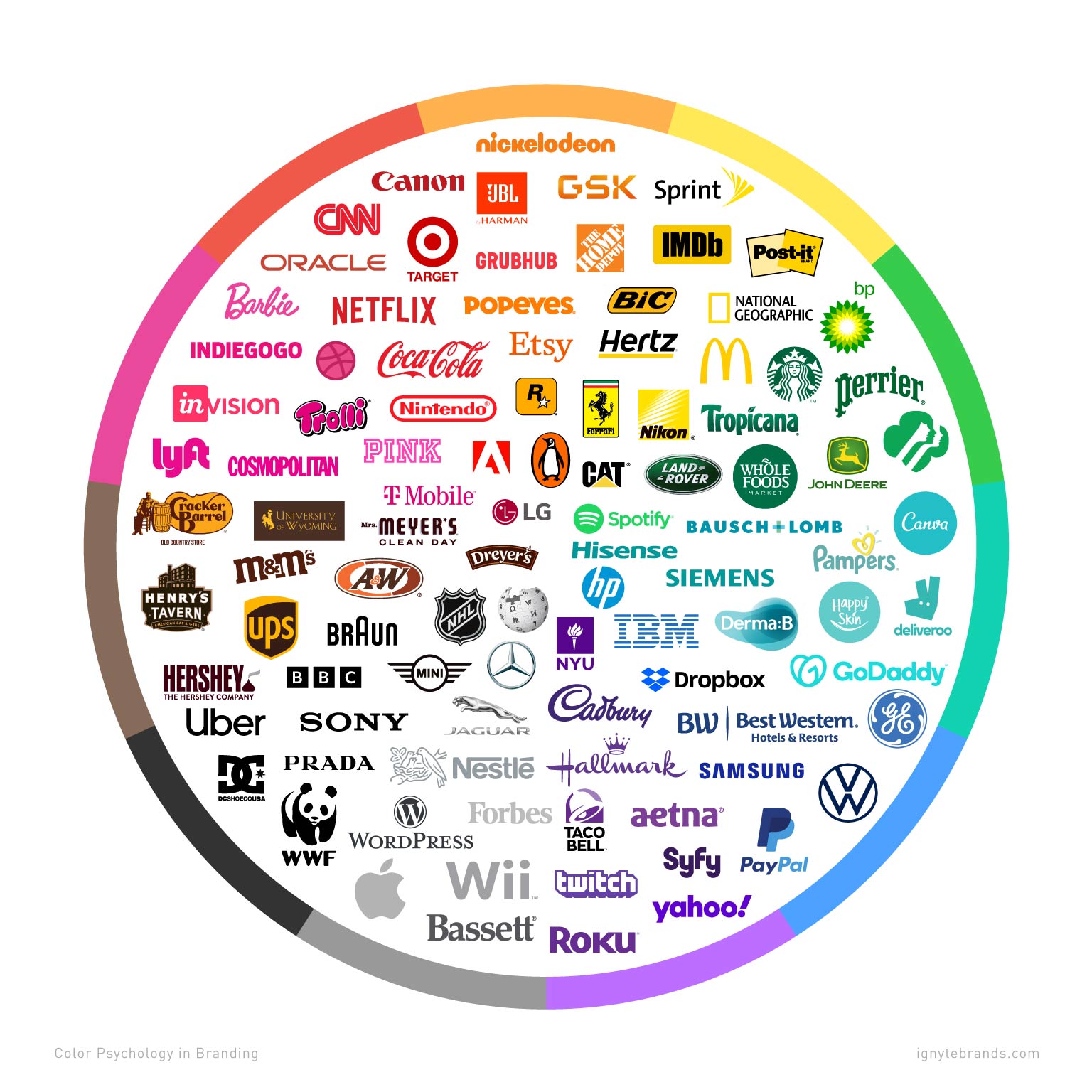
Have you ever wondered why fast food restaurants use so much red and yellow in their logos? Or why luxury brands tend to stick with sleek blacks and golds? The answer lies in the mysterious and powerful world of color psychology. In this article, we’re diving headfirst into the rainbow-hued rabbit hole that is logo design, where every shade has a hidden meaning and every hue is a potential marketing goldmine. So buckle up, folks, because we’re about to color outside the lines and unveil the psychology of color in logo design like never before!
Understanding the Role of Color Psychology in Logo Design
Colors may seem like a simple aspect of logo design, but they actually play a crucial role in influencing how people perceive your brand. Let’s dive into the colorful world of color psychology and see how it impacts logo design:
1. The Power of Red: Red is a bold and attention-grabbing color that evokes feelings of passion, excitement, and urgency. It’s no wonder that many fast food chains and clearance sales use red in their logos to stimulate appetite and create a sense of urgency to buy.
2. Going Green: Green is often associated with nature, growth, and freshness. Companies that want to convey a message of sustainability and eco-friendliness often opt for green in their logos. It’s a color that makes you feel like you’re breathing in fresh air!
3. Feeling Blue: Blue is a calming, trustworthy, and reliable color. That’s why many banks, tech companies, and healthcare providers use shades of blue in their logos to instill a sense of security and dependability. It’s like a warm blanket for your brand!
Impact of Color on Consumer Perception
Ever wonder why fast-food chains often use red and yellow in their logos? It’s not just because those colors stimulate hunger (although that’s a factor). Color plays a huge role in how consumers perceive products and make purchasing decisions. Here are a few ways color can impact consumer perception:
- Emotional Connection: Certain colors evoke specific emotions. For example, blue is often associated with trust and dependability, which is why many financial institutions use it in their branding.
- Brand Recognition: Consistent use of color can help build brand recognition. Think about the distinctive shade of Tiffany blue or the iconic red of Coca-Cola. These colors instantly bring the brand to mind.
But it’s not just about using a single color. The combination of colors also matters. For example, using complementary colors can create a sense of balance and harmony, while contrasting colors can grab attention and create a sense of excitement.
So, next time you’re designing packaging or creating a logo, think about the impact of color. It could make all the difference in how consumers perceive your brand!

Choosing the Right Colors to Convey Brand Message
When it comes to choosing the right colors to convey your brand message, it’s important to remember that colors can make or break your brand’s identity. Here are some tips to help you select the perfect hues that will speak to your audience:
1. Understand color psychology: Each color has its own unique message and can evoke different emotions. For example, red can convey passion and excitement, while blue can represent trust and dependability. Consider what emotions you want your brand to evoke and choose colors that align with that message.
2. Consider your target audience: Think about who your target demographic is and what colors they are drawn to. If you’re targeting children, bright and playful colors like yellow and orange might be more appealing. On the other hand, professional services may opt for more muted tones like gray and navy blue.
3. Don’t be afraid to be bold: While it’s important to consider your audience, don’t be afraid to choose colors that are unexpected or unconventional. Sometimes, a unique color palette can help your brand stand out from the competition and make a lasting impression on customers.

Psychological Associations of Different Color Palettes
Have you ever stopped to think about the psychological effects of the color palettes you choose for your home or office space? It turns out that the colors you surround yourself with can have a big impact on your mood and productivity. Let’s dive into the fascinating world of color psychology!
Whether you prefer bold and vibrant colors or soft and muted tones, each color palette has its own unique associations:
- Red, Orange, Yellow: Bright and energetic color palettes like these are known to stimulate the senses and increase energy levels. They can help you feel more awake and alert, making them great choices for workspaces or areas where you need to focus.
- Blue, Green, Purple: Cool and calming color palettes are perfect for creating a sense of relaxation and tranquility. These colors are often associated with feelings of peace and serenity, making them ideal for bedrooms or meditation spaces.
- Black, White, Gray: Sleek and sophisticated color palettes like these can evoke a sense of modernity and elegance. They are often used in minimalist designs to create a clean and uncluttered aesthetic.
So, next time you’re choosing a color palette for a room, consider the mood you want to create and pick your colors accordingly. Whether you want to feel energized, calm, or chic, there’s a color palette out there to match your vibe!

Utilizing Color Theory to Create Memorable Logos
When creating a memorable logo, color theory is your best friend. By understanding how different colors interact with each other and with your audience, you can create a logo that stands out and leaves a lasting impression.
Here are some tips for utilizing color theory in your logo design:
- Contrast is key: Make sure the colors you choose have enough contrast to be easily distinguishable. A logo that blends in with the background is like a ninja – it disappears before you even know it was there.
- Consider color psychology: Different colors evoke different emotions in people. For example, red can symbolize passion and excitement, while blue can convey trust and stability. Choose colors that align with your brand’s personality.
- Limit your color palette: While it may be tempting to use every color in the rainbow, too many colors can overwhelm the viewer. Stick to a few key colors that represent your brand effectively.
Remember, a well-designed logo will not only catch the eye of potential customers, but it will also communicate the essence of your brand. So, don’t be afraid to play with color and experiment until you find the perfect combination that speaks volumes about your business.
Case Studies: Successful Logo Designs and Their Use of Color Psychology
Ever wondered why certain logos catch your eye and stick in your memory? It’s all about color psychology, my friends! Let’s take a look at some successful logo designs that use color to their advantage:
1. **McDonald’s** – Ah, the golden arches. That iconic red and yellow color scheme isn’t just appetizing, it’s clever! Red stimulates hunger and yellow signifies happiness, making it the perfect combo for a fast-food chain. It’s no wonder we’re all lovin’ it!
2. **Starbucks** – The green mermaid siren is more than just a pretty face. Green represents growth and freshness, which ties in perfectly with this coffee giant’s commitment to sustainability and quality. Plus, it’s a nice nod to all that caffeine-induced energy we get from their brews!
3. **Nike** – Just do it, right? And they definitely did with their use of black and white. Black exudes power and sophistication, while white represents purity and simplicity. It’s a winning combo that has athletes everywhere just doing it in style!
FAQs
Why is choosing the right color important in logo design?
Oh, dear reader, imagine a world where your favorite fast food joint had a logo in shades of gray. Would you still get those cravings for a juicy burger or a crispy fried chicken? Color plays a crucial role in evoking emotions and establishing brand identity, making it essential in logo design.
How do different colors impact our psychology?
Ah, the age-old question! Red gets your heart racing like a high-speed chase scene in a movie, while blue calms you down like a chill day at the beach. Green whispers thoughts of nature and eco-friendliness, while yellow screams, “Hey, look at me!” Each color has its own superpower in manipulating our emotions.
What colors are best suited for creating a trustworthy logo?
Picture yourself in a dark alley at midnight. Would you trust a shady figure in a hot pink suit or someone in a crisp navy blue attire? Exactly. Colors like blue, green, and gray are the Gandalfs of the color world – wise, trustworthy, and dependable. Use them to make your logo the beacon of reliability.
Can colors in a logo influence purchasing decisions?
Oh, absolutely! Think of it like this – would you buy a luxury car in a neon orange hue or a sleek silver shade? Colors can sway our purchasing decisions faster than a magician pulling a rabbit out of a hat. Pick the right colors, and watch your sales skyrocket.
How can contrasting colors be used effectively in logo design?
Imagine if Romeo had never met Juliet, or if Batman had no Joker to battle with. Boring, right? Contrasting colors create drama, intrigue, and visual interest in your logo design. Pair up colors like black and white, or yellow and purple, to make your logo pop like fireworks on the fourth of July.
In conclusion: Color Me Impressed!
Thanks for diving into the fascinating world of color psychology in logo design with us. We hope this article has “colored” your perspective on how hues can influence consumer perception and emotion. Remember, when it comes to creating a standout logo, don’t be afraid to think outside the color box!












